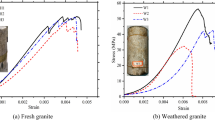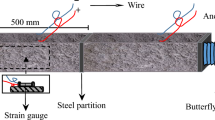Abstract
A modified spherical cavity-expansion model is developed in this paper. (1) We introduce a piecewise hyperbolic yield criterion suitable for pressure less than fc/3 to describe the mechanical behavior in the elastic region for the elastic–plastic response and modify the crack occurrence condition for the elastic–cracked–plastic response. (2) The hyperbolic yield criterion and a piecewise equation of state (EOS) are adopted for a better description of the plastic behavior of concrete material. Then, the modified model is validated by several projectile penetration tests in both the normal strength concrete (NSC) and ultra-high performance cement-based composite (UHPCC) targets. Finally, the hydrostatic pressure of the targets under rigid ogive-nosed projectile penetrations is found to be nearly within (0, 1.6 GPa), which usually exceeds the range that the shear strength-pressure test data covered. The influence of yield criterion on depth of penetration is discussed and it is recommended that the pressure should arrive at least 400 MPa in the related triaxial compression tests.

















Similar content being viewed by others
Abbreviations
- A, B, C :
-
Dimensionless resistance constants
- B 1, B 2; C 1, C 2 :
-
Constants of integration
- b 0, b 1, b 2 :
-
Constants in yield criterion
- c, c 1 :
-
Interface velocities
- c d :
-
Dilatational velocity
- c p = (E/ρ 0)0.5 :
-
Reference velocity
- d :
-
Projectile diameter
- E :
-
Elastic modulus
- f c :
-
Unconfined compressive strength
- f t :
-
Uniaxial tensile strength
- F = f t/f c :
-
Dimensionless tensile strength
- K g :
-
General value of bulk modulus
- m :
-
Projectile’s mass
- N 1, N 2 :
-
Projectile nose shape coefficients
- P :
-
Hydrostatic pressure
- P g :
-
General intercept pressure in the equation of state (EOS)
- r :
-
Radial Eulerian coordinate
- S = σ r/f c :
-
Dimensionless radial stress
- T = P/f c :
-
Dimensionless pressure
- t :
-
Time
- u :
-
Radial displacement
- U = v/c :
-
Dimensionless particle velocity
- v :
-
Particle velocity
- V :
-
Projectile’s instantaneous velocity
- V 0 :
-
Initial velocity of the projectile
- V r :
-
Cavity-expansion velocity
- x :
-
Instantaneous displacement
- α = c 1/c d :
-
Dimensionless variable
- β 1 = c 1/c p, β = c/c p :
-
Dimensionless interface velocities
- ε = V r/c :
-
Dimensionless expansion velocity
- μ :
-
Volumetric strain
- \( \nu \) :
-
Poisson’s ratio
- ξ 1 = r/(c 1 t), ξ = r/(ct):
-
Dimensionless coordinate
- ρ :
-
Density of the concrete material
- σ r :
-
Radial Cauchy stress
- σ θ :
-
Circumferential Cauchy stress
- ψ :
-
Caliber-radius-head of projectile
- \( \bar{u}_{1} \) = u/(c 1 t):
-
Dimensionless variables
References
Luk, V.K., Forrestal, M.J.: Penetration into semi-infinite reinforced-concrete targets with spherical and ogival nose projectiles. Int. J. Impact Eng. 6, 291–301 (1987)
Forrestal, M.J., Tzou, D.Y.: A spherical cavity-expansion penetration model for concrete targets. Int. J. Solids Struct. 34, 4127–4146 (1997)
He, T., Wen, H.M., Guo, X.J.: A spherical cavity expansion model for penetration of ogival-nosed projectiles into concrete targets with shear-dilatancy. Acta Mech. Sin. 27, 1001–1012 (2011)
Feng, J., Li, W.B., Wang, X.M., et al.: Dynamic spherical cavity expansion analysis of rate-dependent concrete material with scale effect. Int. J. Impact Eng. 84, 24–37 (2015)
Warren, T.L., Forquin, P.: Penetration of common ordinary strength water saturated concrete targets by rigid ogive-nosed steel projectiles. Int. J. Impact Eng. 90, 37–45 (2016)
Kong, X.Z., Wu, H., Fang, Q., et al.: Analyses of rigid projectile penetration into UHPCC target based on an improved dynamic cavity expansion model. Constr. Build. Mater. 126, 759–767 (2016)
Kong, X.Z., Wu, H., Fang, Q., et al.: Rigid and eroding projectile penetration into concrete targets based on an extended dynamic cavity expansion model. Int. J. Impact Eng. 100, 13–22 (2017)
Forrestal, M.J., Luk, V.K.: Penetration into soil targets. Int. J. Impact Eng. 12, 427–444 (1992)
Forrestal, M.J.: Penetration into dry porous rock. Int. J. Solids Struct. 22, 1485–1500 (1986)
Shi, C.C., Wang, M.Y., Li, J., et al.: A model of depth calculation for projectile penetration into dry sand and comparison with experiments. Int. J. Impact Eng. 73, 112–122 (2014)
Hanchak, S.J., Forrestal, M.J., Young, E.R., et al.: Perforation of concrete slabs with 48 MPa (7 ksi) and 140 MPa (20 ksi) unconfined compressive strengths. Int. J. Impact Eng. 12, 1–7 (1992)
Warren, T.L., Fossum, A.F., Frew, D.J.: Penetration into low strength (23 MPa) concrete: target characterization and simulations. Int. J. Impact Eng. 30, 477–503 (2004)
Malvar, L.J., Crawford, J.E., Wesevich, J.W., et al.: A plasticity concrete material model for DYNA3D. Int. J. Impact Eng. 19, 847–873 (1997)
Forrestal, M.J., Luk, V.K.: Dynamic spherical cavity-expansion in a compressible elastic–plastic solid. J. Appl. Mech. 55, 275–279 (1988)
Tu, Z.G., Lu, Y.: Evaluation of typical concrete material models used in hydrocodes for high dynamic response simulations. Int. J. Impact Eng. 36, 132–146 (2009)
Holmquist, T.J., Johnson, G.R., Cook, W.H.: A computational constitutive model for concrete subjected to large strains, high strain rates, and high pressures. In: Proceedings of the 14th International Symposium on Ballistics. Quebec, 591–600 (1993)
Guo, Z.H., Wang, C.Z.: Investigation of strength and failure criterion of concrete under multi-axial stress. Chin. Civ. Eng. J. 24, 1–14 (1991). (in Chinese)
Comite Euro-International du Beton: Bulletin D’information No. 213/214 CEB-FIP model code 1990. Lausanne, May (1993)
Gebbeken, N., Greulich, S., Pietzsch, A.: Hugoniot properties for concrete determined by full-scale detonation experiments and flyer-plate-impact tests. Int. J. Impact Eng. 32, 2017–2031 (2006)
ACI Standard 318-77: Building Code Requirements for Reinforced Concrete. American Concrete Institute, Detroit (1977)
Iravani, Said: Mechanical properties of high-performance concrete. ACI Mater. J. 93, 416–426 (1996)
Forrestal, M.J., Frew, D.J., Hanchak, S.J., et al.: Penetration of grout and concrete targets with ogive-nose steel projectiles. Int. J. Impact Eng. 18, 465–476 (1996)
Ren, G.M., Wu, H., Fang, Q., et al.: Triaxial compressive behavior of UHPCC and applications in the projectile impact analyses. Constr. Build. Mater. 113, 1–14 (2016)
Peng, Y., Wu, H., Fang, Q., et al.: A note on the deep penetration and perforation of hard projectiles into thick targets. Int. J. Impact Eng. 85, 37–44 (2015)
Chen, X.W., Li, Q.M.: Deep penetration of a non-deformable projectile with different geometrical characteristics. Int. J. Impact Eng. 27, 619–637 (2002)
Forrestal, M.J., Altman, B.S., Cargile, J.D., et al.: An empirical equation for penetration depth of ogive-nose projectiles into concrete targets. Int. J. Impact Eng. 15, 395–405 (1994)
Wu, H., Fang, Q., Chen, X.W., et al.: Projectile penetration of ultra-high performance cement based composites at 510 m/s to 1320 m/s. Constr. Build. Mater. 74, 188–200 (2015)
Xiong, Y.B.: Research on constitutive parameters of concrete based on the Johnson–Holmquist concrete model. Northwest Institute Nuclear of Technology, Xi’an (2009). (in Chinese)
Acknowledgements
This project was supported by the National Natural Science Foundations of China (Grants 51522813 and 51438003).
Author information
Authors and Affiliations
Corresponding author
Rights and permissions
About this article
Cite this article
Peng, Y., Wu, H., Fang, Q. et al. Modified spherical cavity-expansion model for projectile penetration into concrete targets. Acta Mech. Sin. 35, 518–534 (2019). https://doi.org/10.1007/s10409-018-0815-7
Received:
Revised:
Accepted:
Published:
Issue Date:
DOI: https://doi.org/10.1007/s10409-018-0815-7




